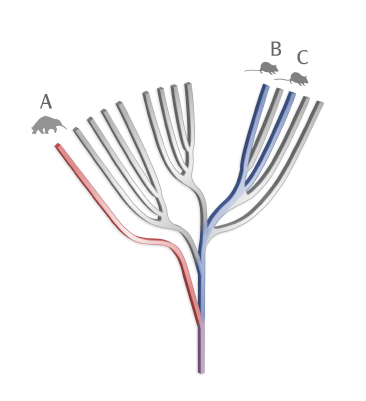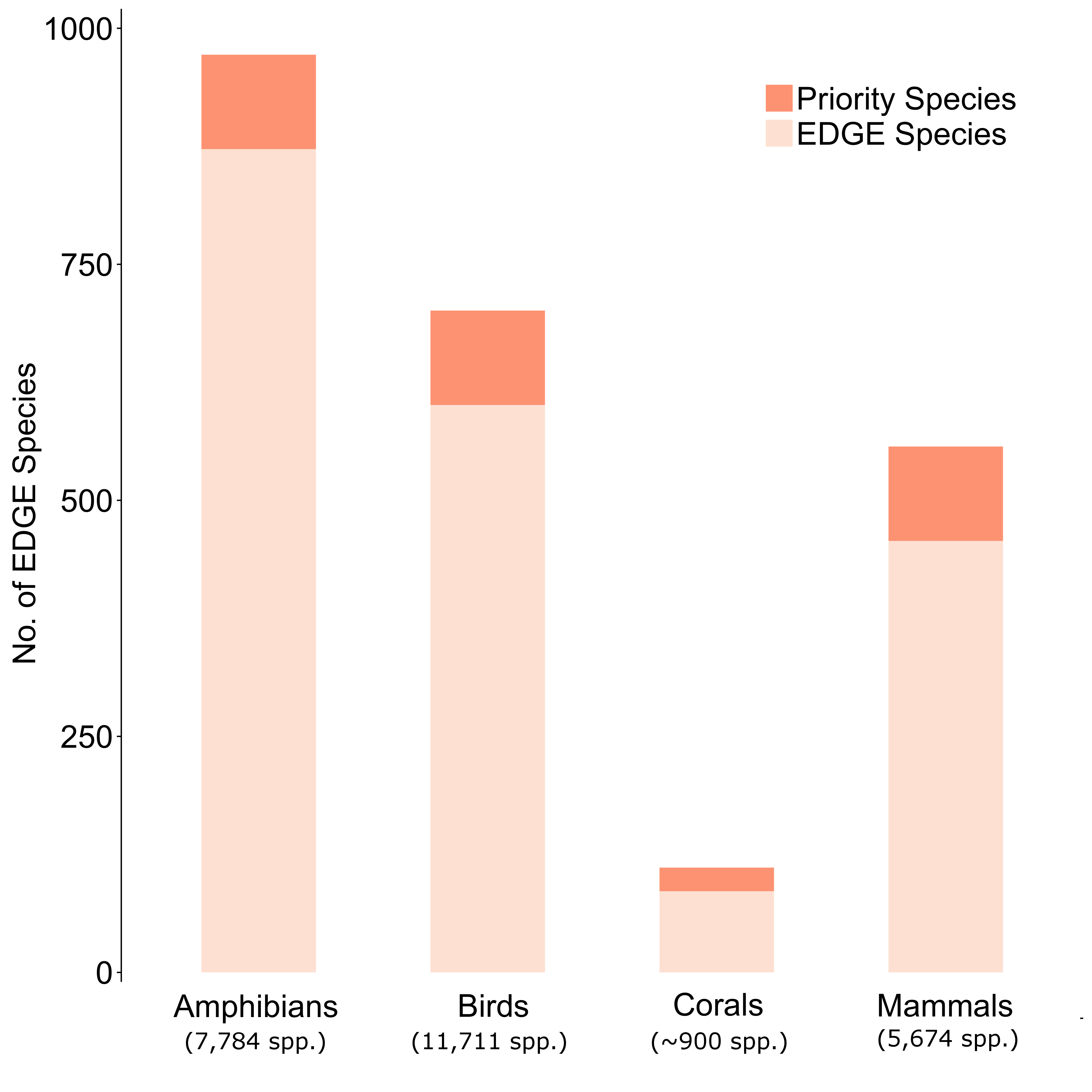Evolutionarily Distinct and Globally Endangered (EDGE) species are threatened species that have few or no close relatives on the Tree of Life. EDGE species represent large amounts of threatened evolutionary history, and are often extremely distinct in the way they look, live and behave as well as in their genetic make-up. If they disappear, there will be nothing like them left on the planet.
How we identify priority EDGE species
We score every species in a particular taxonomic group (e.g. mammals or amphibians) according to the amount of unique evolutionary history it represents (Evolutionary Distinctiveness, or ED), and its conservation status (Global Endangerment, or GE). We then combine these scores to give each species an EDGE score. Those with high ED and GE get the highest EDGE scores and are our priority species.
Evolutionarily Distinct
Some species are more distinct than others because they represent a larger amount of unique evolution. Species like the tuatara have no close relatives and have been evolving independently for many millions of years. Others, like the brown rat, originated relatively recently and have many close relatives.
One way to quantify the uniqueness of a species is to calculate its Evolutionary Distinctiveness (ED) using an evolutionary tree, or phylogeny. A phylogeny is a representation of the evolutionary relationships between a set of species. The phylogenies we use to calculate ED scores are calibrated in such a way that the branches of the ‘tree’ represent the millions of years of evolution that has taken place since the origin of the group. When calculating ED scores, each species on the phylogeny receives a ‘fair proportion’ of the branches that connect them to all other species. If the branches connecting a species to the rest of the tree are shared with fewer species, it receives a larger the proportion of the millions of years represented by each branch and therefore a higher ED score.

In the example phylogeny above, species A has a higher ED score than either species B or C. This is because species A is alone on a long branch of the tree of life, whereas species B and C are on short twigs, surrounded by close relatives. If species A were to go extinct, there would be no similar species left on the planet and a disproportionate amount of unique evolutionary history would be lost forever. At the EDGE of Existence programme we would prioritise species A, as long as resources for conservation are limited and each species is equally threatened.
The world’s most Evolutionarily Distinct mammal is the Aardvark. The most distinct amphibian is the Mexican burrowing toad, the most distinct bird is the Oilbird, and the tuatara is the most Evolutionarily Distinct reptile.
Globally Endangered
Globally Endangered (GE) scores for each species are based on the IUCN Red List Categories (Critically Endangered, Endangered, Vulnerable, Near Threatened and Least Concern). The IUCN Red List of Threatened Species is the world’s most comprehensive assessment of the conservation status of plant and animal species. Species which are Critically Endangered receive a higher score than less threatened species, which in turn, receive a higher score than those not currently in danger of extinction.

EDGE Scores
The ED and GE scores are combined to produce an overall EDGE score for each species. While we can currently only calculate EDGE scores for species with IUCN Red List assessments that are not Data Deficient, research is ongoing to develop a method for calculating EDGE scores that can incorporate species for which we lack IUCN Red List data.
Read the original EDGE mammals scientific paper to find out more about how EDGE scores are calculated.

EDGE Species
EDGE species are species that have an above median ED score and are also threatened with extinction (Critically Endangered, Endangered or Vulnerable on the IUCN Red List). There are currently over 550 EDGE mammal species (~10% of all species) and over 900 EDGE amphibian species (~13% of all species). Potential EDGE species are those with high ED scores but whose conservation status is unclear. We highlight the top 25 EDGE corals and top 100 EDGE amphibians, birds, mammals and reptiles as our priority EDGE species. These represent the most unique species for which conservation action is of utmost importance.
Follow the links to view the Top 100 EDGE mammals, amphibians, birds and the Top 25 EDGE corals.

Current Research
We are continuously developing the scientific foundation of our conservation work. Click here to read more about EDGE’s current research activities.